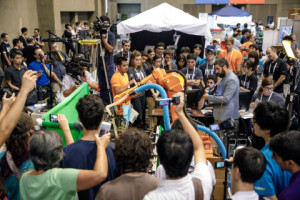Australian Centre for Robotic Vision has taken the $80,000 overall prize in the Amazon Robotics Challenge which took place over four days in Nagoya, Japan.
Nanyang Technological University of Singapore won the Pick Task, while MIT Princeton of the US, won the Stow Task.
Teams were judged based on how many items were successfully picked and stowed by their robots in a fixed amount of time.
A total of $270,000 in prizes were awarded to contestants throughout the four-day competition.

This year’s Amazon Robotics Challenge was held during RoboCup, the competition for intelligent robots, at the Nagoya International Exhibition Hall.
“This year, we made some changes to the challenge to make it even more difficult and to encourage broader participation from multiple robotics fields – and the response was exciting,” said Joey Durham, contest chairperson and manager of research and advanced development for Amazon Robotics.
“The versatility of recognition capabilities in an unstructured environment and the dexterity of grasping mechanisms was truly impressive. What we’re most proud of with the Amazon Robotics Challenge is its celebration of robotic community and the venue it’s created to share and promote research in a fun and rewarding way.”
The Australian Centre for Robotic Vision team consisted of researchers, early PhD candidates and undergraduate students who combined computer vision, machine learning and a variety of robotic hardware to successfully complete both pick and stow tasks the fastest. Below is additional information on all winners.
Grand Championship in Combined Task
1st: ACRV, Australian Centre for Robotic Vision
2nd: NimbRo, University of Bonn, Germany
3rd: Nanyang, Nanyang Technological University. Singapore
Pick Task
1st: Nanyang, Nanyang Technological University. Singapore
2nd: NimbRo, University of Bonn, Germany
3rd: IITK TCS, Indian Institute of Technology Kanpur, Tata Consultancy Services India
Stow Task
1st MIT-Princeton, MIT-Princeton USA
2nd Nanyang, Nanyang Technological University, Singapore
3rd MC^2, Mitsubishi Electric, Chubu University, Chukyo University, Japan






